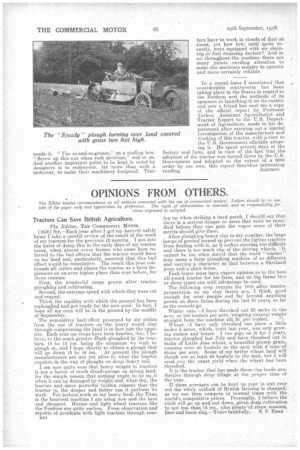. OPINIONS• FROM OTHERS.
Page 20

If you've noticed an error in this article please click here to report it so we can fix it.
The Editor invites correspondence on all subjects connected with the use of commercial MOIM. Letters should be on one, side of the paper only and typewritten by preference. The right of abbreviation is reserved, and no responsibility for views expressed is accepted.
Tractors Can Save British Agriculture.
The Editor, THE COMMERniAL MoTon.
[1630] Sir,—Each year after I get my harvest safely home I take a careful review of the result of the work of my tractors for the previous 12 months. I got into the habit of doing this in the early days of my tractor using, when almost every farmer who came here referred to the bad effects that the tractor would have on my land and, particularly, asserted that this bad effect would be cumulative. The result this year confounds all critics and places the tractor as a farm implement on an even higher plane than ever before, for three reasons.
. First, the wonderful crops grown after tractor ploughing'and cultivating.
Second, the extreme speed with which they were cut and reaped.
Third, the rapidity with which the ground has been reploughed and got ready for the new seed. In fact, I hope all my corn will be in the ground by the middle of September.
The cumulative badt effect promised by my critics from the use of tractors on the heavy weald clay through compressing the land is in fact Just the opposite. Each year my crops have been heavier' due I believe, to the much greater apth ploughed by the tractors, II to 12 ins, being the minimum we wish to plough at, and I hope shortly to obtain a plough that will go down 15 to 16 ins. At present the plough manufacturers are' not yet alive to what the tractor requires in the way of ploughs on deep, heavy soil.
I am now quite sure that heavy weight in tractors is not a factor of much disadvantage on atrong land, for the simple reason that nothing ought to be on .it when it can he damaged by weight and, when dry, the heavier and more powerful (within reason) that the tractor is, the deeper and better can it perform its work. For serious work on my heavy land, the Titan is the heaviest machine I am using now and the best and cheapest. Horses and light wheel tractors. like the Fordson are quite useless. From observation and reports of accidents with light tractors 'through rear
B-14 ing up when striking a hard patch. I should say that there is a serious danger to users that must be remedied before they can gain the vogue some of their merits should give them.
After ploughing heavy clay in dry weather, the large lumps of ground turned up prevent the lighter tractors from dealing with it, as it makes steering too difficult and there is too much slip of the driving wheels. It cannot be Vs() often stated that the wor-d. " tractor " may mean a farm ploughing machine of as different and varying a. character as that between a Shetland pony and a shire horse.
Each buyer must have expert opinion as to the best all-round tractor for his farm, and on. big farms two or three types can with advantage be used. The following crop returns for 1918 after tractor, preparation on my clay farms are, I think, good enough , for most people and far beyond anything grown on these farms during the last 50 years, so far as the records go.
Winter oats.—I have threshed out 26 sacks to the acre, or 104 bushels per acre, weighing natural weight• straight from the machine 421 lb: per bushel:
Wheat. -I have only threshed one piece a little under 5 acres, which, until last year, was only growing'rushes and briars I ran pigs on it for 3 years, tractor ploughed last July and have threshed, out 5t sacks of Little Joss wheat, a beautiful plump grain, running over 40 bushels to the ,acre with 2 tons of S'braw per acre. Some of my better wheat land will thresh out at least 64 bushels 'to the acre' but I will send you the exact yield when the wheat has been threshed.
It is the tractor that has made these clay lands productive through deep tillage at the proper time of the year.
If these averages can be kept up year in and year out the whole outlook of British fanning is changed, as we can then compete in normal' times with the world's competitive prices. Personally, I believe the yield will go up and not down, given deep cultivation to not less than 12 ins., plus plenty of straw manure, lime and basic slag.—Yours faithfully, S. F. EDGE •






















